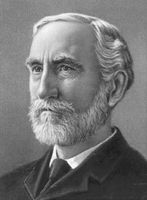Translation and analysis of words by ChatGPT artificial intelligence
On this page you can get a detailed analysis of a word or phrase, produced by the best artificial intelligence technology to date:
- how the word is used
- frequency of use
- it is used more often in oral or written speech
- word translation options
- usage examples (several phrases with translation)
- etymology
Gibbs function - translation to russian
общая лексика
функция энергии Гиббса
общая лексика
(свободная) энергия Гиббса
синоним
[gɪbz]
общая лексика
"Гиббз" (фирменное название парфюмерно-косметических товаров одноимённой компании, контролируемой концерном "Юнилевер" [Unilever])
Definition


Wikipedia
In thermodynamics, the Gibbs free energy (or Gibbs energy as the recommended name; symbol ) is a thermodynamic potential that can be used to calculate the maximum amount of non-volume expansion work that may be performed by a thermodynamically closed system at constant temperature and pressure. It also provides a necessary condition for processes such as chemical reactions that may occur under these conditions. The Gibbs free energy is expressed as where p is pressure, T is the temperature, U is the internal energy, V is volume, H is the enthalpy, and S is the entropy.
The Gibbs free energy change (, measured in joules in SI) is the maximum amount of non-volume expansion work that can be extracted from a closed system (one that can exchange heat and work with its surroundings, but not matter) at fixed temperature and pressure. This maximum can be attained only in a completely reversible process. When a system transforms reversibly from an initial state to a final state under these conditions, the decrease in Gibbs free energy equals the work done by the system to its surroundings, minus the work of the pressure forces.
The Gibbs energy is the thermodynamic potential that is minimized when a system reaches chemical equilibrium at constant pressure and temperature when not driven by an applied electrolytic voltage. Its derivative with respect to the reaction coordinate of the system then vanishes at the equilibrium point. As such, a reduction in is necessary for a reaction to be spontaneous under these conditions.
The concept of Gibbs free energy, originally called available energy, was developed in the 1870s by the American scientist Josiah Willard Gibbs. In 1873, Gibbs described this "available energy" as: 400
the greatest amount of mechanical work which can be obtained from a given quantity of a certain substance in a given initial state, without increasing its total volume or allowing heat to pass to or from external bodies, except such as at the close of the processes are left in their initial condition.
The initial state of the body, according to Gibbs, is supposed to be such that "the body can be made to pass from it to states of dissipated energy by reversible processes". In his 1876 magnum opus On the Equilibrium of Heterogeneous Substances, a graphical analysis of multi-phase chemical systems, he engaged his thoughts on chemical-free energy in full.
If the reactants and products are all in their thermodynamic standard states, then the defining equation is written as , where is enthalpy, is absolute temperature, and is entropy.

![The reaction C<sub>(s)</sub><sup>diamond</sup> → C<sub>(s)</sub><sup>graphite</sup> has a negative change in Gibbs free energy and is therefore thermodynamically favorable at 25 °C and 1 atm. However, the reaction is too slow to be observed, because of its very high [[activation energy]]. Whether a reaction is thermodynamically favorable does not determine its rate. The reaction C<sub>(s)</sub><sup>diamond</sup> → C<sub>(s)</sub><sup>graphite</sup> has a negative change in Gibbs free energy and is therefore thermodynamically favorable at 25 °C and 1 atm. However, the reaction is too slow to be observed, because of its very high [[activation energy]]. Whether a reaction is thermodynamically favorable does not determine its rate.](https://commons.wikimedia.org/wiki/Special:FilePath/Diamond.jpg?width=200)

![thermodynamic surface]]''' diagram for a fictitious water-like substance, transposed the two figures of Gibbs (above right) onto the volume-entropy coordinates (transposed to bottom of cube) and energy-entropy coordinates (flipped upside down and transposed to back of cube), respectively, of a three-dimensional [[Cartesian coordinates]]; the region AB being the first-ever three-dimensional representation of Gibbs free energy, or what Gibbs called "available energy"; the region AC being its capacity for [[entropy]], what Gibbs defined as "the amount by which the entropy of the body can be increased without changing the energy of the body or increasing its volume. thermodynamic surface]]''' diagram for a fictitious water-like substance, transposed the two figures of Gibbs (above right) onto the volume-entropy coordinates (transposed to bottom of cube) and energy-entropy coordinates (flipped upside down and transposed to back of cube), respectively, of a three-dimensional [[Cartesian coordinates]]; the region AB being the first-ever three-dimensional representation of Gibbs free energy, or what Gibbs called "available energy"; the region AC being its capacity for [[entropy]], what Gibbs defined as "the amount by which the entropy of the body can be increased without changing the energy of the body or increasing its volume.](https://commons.wikimedia.org/wiki/Special:FilePath/Gibbs-Maxwell surfaces.png?width=200)
